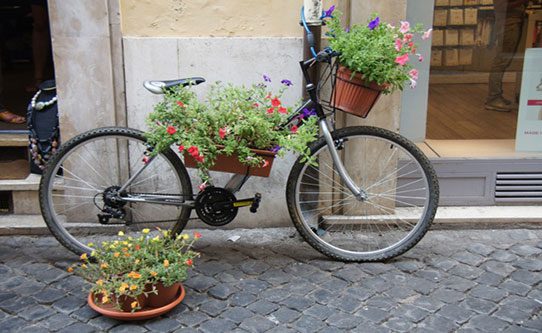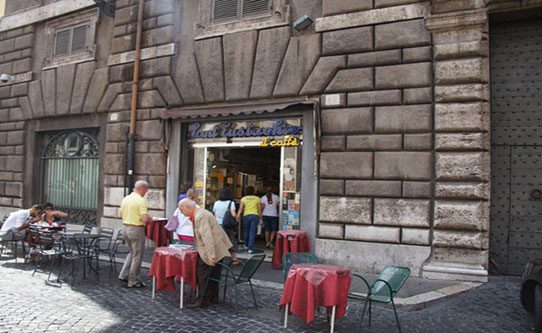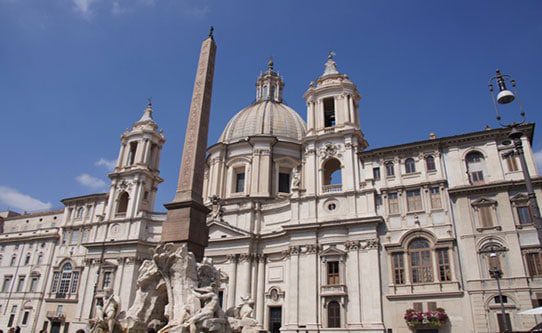Relevant Links:
52 Things to Know Before Traveling to Italy with Kids
10 Off-the-Beaten-Path Family Activities in Rome
The Eternal City is made up of many neighborhoods, and choosing where to stay in Rome with kids can be overwhelming. The final decision should be made based on the type of experience you want to have, what you want to explore while you’re there, and the accommodation category — hotel, apartment or villa. This determines the best location to stay in Rome with families.
Our Rome family hotels list is comprised of options near the main tourist attractions. Of course, you pay a premium for convenience, particularly during the peak family travel periods. A long-time Rome expert, Patrice Salezze, provides an overview of the different neighborhoods and locations in the city. Patrice runs Papavero Rentals, an exceptional villa and apartment rental agency covering all of Italy. Our travel advisors can connect you to the portfolio of rental options, as well as advise on the best hotels in the city that meet your family’s needs.

Colosseum/Palatine Hill/ Roman and Imperial Forum/Circus Maximus
Considered by modern Romans as the center of Rome, it was also the heart of Ancient Rome. Legend has it that Romulus founded Rome here, between the Circus Maximus and the Palatine Hill. Walk down any street and you are reminded of ancient Rome with incredible monuments that date as far back as 2,000 years. The Temple Vesta’s footprint can be traced back to the 7th century BC.
Pros: Very quiet in the evenings, ensuring a good night sleep. Two metro stops, Colosseo and Circus Maximus, will get you easily to the Spanish Steps and on to the Vatican. It’s steeped in ancient history, and a short 10-minute walk to the Campo de’Fiore. A 15-minute walk will take you over the Tiber river into the Trastevere district, where you will find many good and inexpensive trattorie.
Cons: Limited restaurants and shops in the immediate area; very quiet neighborhood in the evenings.
Things to see: Bocca della Verita, Colosseum, Palatine Hill, Roman and Imperial Forums, Circus Maximus, Piazza Venezia. Farther south are the Baths of Caracalla. Picnic in Villa Celimontana, one of the prettiest parks in Rome.
The apartments at the Palazzo Romulus e Remus are ideal for families. With a minimum stay of 3 days, this hotel-like apartment building has a reception desk with 24/7 assistance. The staff is happy to call a taxi, make dinner reservations and offer touring advice. The rental also includes daily maid service and a continental buffet breakfast that can be enjoyed in the chic Palace Café or brought back up to your apartment.
Our Family Vacation Consulting Team will work with you to book accommodations, recommend activities and more, all with one-on-one support. Click here to send us a request >
Romans may consider Ancient Rome the city’s center, but most tourists agree that for sightseeing, the Piazza Navona neighborhood is within ideal walking distance to a majority of sights. This area was also rebuilt during the Renaissance and Baroque periods, as denoted by its architecture. A short 10-minute walk from ancient Rome, this area includes the Jewish district, Campo de’ Fiore, Piazza Navona, the Pantheon and the Trevi Fountain.
Pros: Centrally located; monuments and churches are all within walking distance of each other. No need for public transportation or taxis.
Cons: Can be loud in some areas. Campo de’Fiore is active from the early morning hours onward, when the campo is turned into a daily market. The setup starts early in the morning, breaks down by 3:00 and comes alive again from 10 pm to 2 am as the gathering place for high school and college students. The road along the Tiber has heavy traffic and the sirens from the many ambulances servicing the two main hospitals can disturb light sleepers.
Things to see: If Venice’s living room is Piazza San Marco, then Rome’s is Piazza Navona. Musicians, mimes and artists are set along the oval piazza. It is a great area to people-watch. We recommend sitting outside Tre Scalini’s while enjoying the world famous Tartufo gelato confection invented in this very restaurant. Stroll the antique street of Via Giulia to the Ponte Sisto (Sisto Bridge), the Pantheon and the Church of Santa Maria Sopra Minerva. Four beautiful Caravaggio paintings still hang in the church of San Luigi dei Francesi.
The Jewish Ghetto has a Jewish museum and synagogue and very good restaurants. Also visit the Trevi Fountain, the National Gallery of Ancient Art, Palazzo del Quirinale and the Scuderie Quirinale.

Spanish Steps/Piazza del Popolo
This neighborhood can be called the meeting place of Rome. There are signs throughout the city pointing in the direction of the Spanish Steps, and they are an easy place to meet your friends, family or tour guide. The steps also give you a nice, relaxing place to wait — with or without a gelato! This district was built in the 16th century and its streets are filled with the most famous and luxurious shops and hotels. Bustling with tourists from day to night, it is still an ideal place to stay for its great location and easy access to transportation.
Take a stroll up Via del Corso to the infamous and breathtaking Piazza del Popolo, with the mirror-image churches of Santas Maria del Miracoli and Montesanto. Rome’s most elegant garden, the Borghese, is an escape from the city and offers a tranquil place where you can rent bikes, picnic or just stroll on a Sunday afternoon alongside Roman families.
Pros: Ideal location; lots of activity yet quiet, peaceful nights. Convenient transportation with the Spanish Steps Metro and a large taxi queue. Fashion designer stores on Via Condotti; more shopping on Via Frattina. Gelato and cafes abound. Easy walking distance to many sites, including the Piazza Navona area.
Cons: A tourist-focused area means higher prices in restaurants and shops. Add the high price of real estate, and the cost of accommodations in this area is higher than in others.
Things to see: Keats-Shelly house, the Ara Pacis (Arch of Peace), the Villa Borghese art museum and the Etruscan Museum. Take a seat on the Spanish steps after a morning of shopping on Via Condotti.
For convenience and luxury, the Moda apartments are just a few meters from the Spanish steps and the perfect place to return between sightseeing trips. These two apartments are on the same floor, sleeping 5 and 6 guests, respectively; they can be joined together for extended families of up to 11. The evenings are so quiet you can keep your windows open during the night.

The literal translation of Trastevere is “beyond the Tiber.” This area was the medieval home of the city’s working class and much ignored until the last 30 years. It is now the district young Romans dream of moving into, but many can’t afford it. A colorful neighborhood with a Bohemian flavor, it abounds with pizzerias, gelato shops, cafés and pastry shops; it has become the Soho of Rome.
Pros: A fun neighborhood with less expensive apartments and hotels, lots of medieval and ancient Roman buildings and streets. Inexpensive pizzerias and cafés abound.
Cons: A little farther walk to the historic center of Rome. It can be loud in the evenings, especially on weekends. More pickpocketing happens in this area than in the historic center.
Things to see: Walk across the Tiber to Trastevere by way of the Cestio bridge that crosses the Tiber Island. Stop into the church of Saint Cecilia, patron saint of music. The beautiful church of Santa Maria in Trastevere sits in the square of the same name. It’s a pleasure to take a leisurely stroll through the tiny streets full of charm and character.

The Vatican area is above Trastevere, and is a perfect location for those concentrating on Vatican events. A 10-minute taxi ride will take you to the historic center of Rome.
Pros: Close to the Vatican City and Castel Sant’Angelo
Cons: There’s not much else to do in this area in the evenings. Reaching the historic center requires the metro, a taxi or a 30-minute walk.
Things to see: The Vatican Museums house multiple buildings that include the Sistine Chapel, the Raphael Rooms, the Gallery of Map and many more.
In medieval times, the area outside of St. Peter’s was called “rhe Borgo,” a small neighborhood that catered to pilgrims. (This is the reason so many street names start with the word Borgo.) From St. Peter’s Basilica, walk down Via dei Corrodori, which turns into Borgo Sant’Angelo and leads to catel Sant’Angelo.
Note the high rampart above Via dei Corrodori — this is the path that past popes would take to reach the safety of Castel Sant’Angelo. You can retrace those steps by taking a tour; book in advance.
This area is the main hub of public transportation within the city. The primary train and bus stations are here and both the A and B metro lines intersect at Termini train station. Tour buses line up for Rome sightseeing tours as well as day trips to other areas of Italy.
Pros: Access to all major sights and areas of Rome and environs; plenty of budget hotels and restaurants.
Cons: Heavy traffic, bus fumes and lack of charming atmosphere. Be careful when choosing a hotel as some areas are a bit run-down.
Things to see: The ruins of the Baths of Diocletian, thermal baths built in 306 AD. In the 16th century, an aging Michelangelo was commissioned to convert part of the baths into the Church of Santa Maria degli Angelica. Arrive there on a sunny midday to view the meridian built in 1703: Light shines through an opening high up on the wall and falls across a brass strip marking the north-south meridian of Rome. For 150 years, noon was defined when the sun’s rays lined up with the brass strip. Visit the church of Santa Maria della Vittoria for Bernini’s famous St. Theresa.
We've paired our favorite accommodations and activities in one easy, book-and-go package. Get more details and make a request >
Want to save all the great intel and tips you are finding on Ciao Bambino? My Trip Planner allows you to bookmark articles, family-friendly hotel reviews, and family vacation packages. Simply click the heart icon on anything you want to save. Site registration is required to get started. Happy planning!
Please fillout the form below to create your free My Trip Planner account.
Lovely tour and highlights of the neighborhoods.I love walking around Rome and visiting the historic sites. One of my favorite spots to visit is the Trastevere and trying the many food venues there is amazing.